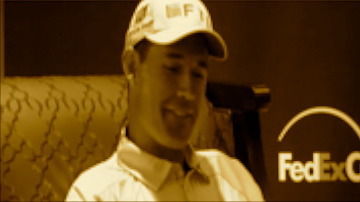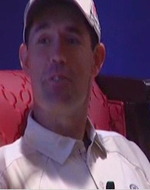Harrington learning to master himself

Padraig Harrington has 37 days to get his game in shape for the Masters and when he sat down with his mental coach Bob Rotella for a chat on Monday, he revealed that he felt like a naughty schoolboy confessing his misdeeds to the dean of studies.
Since he was sent packing by Jeev Milkha Singh in the first round of the WGC-Accenture Match Play Championship in Tucson two weeks ago, he’s spent his time tinkering with his game. Old habits die hard but Harrington and Rotella know that it’s not ideal with just five weeks to go before the Masters.
After the painful lessons of 2009 - when he missed nine of the first 16 cuts before finally giving up the swing tinkering - was this a sign of a relapse by the self-confessed practice ground junkie?
“I’m a lot happier with what I tinkered with,” Harrington said at the Honda Classic on Tuesday morning. “I sat down with my sports psychologist, Dr Bob Rotella, yesterday and I could see him looking at me like I was a bold schoolboy.
“I was sitting there telling him what I was thinking and he was going ‘this sounds very familiar – you’re getting back into your old bad habits’. No doubt, there’s an element of that. I’ve been home the last 10 days and I spent all 10 of them hitting a lot of golf shots. That puts a lot into the mix and it’s hard to quieten down (mentally) and that’s what I have to do to be competitive.”
Harrington has had nothing better to do for the last two weeks than hit balls. What else can he do when he has played just six strokeplay rounds and 17 holes of matchplay since he packed it in for the winter at the Chevron World Challenge in California nearly three months ago.
“It’s kind of hard to shut my brain down at the moment. The more competitive rounds of golf I play, the quieter my mind gets and the more into playing I am and the less into practice. It always takes me a little bit of time. Last year it took six months, I couldn’t stop. But this year I don’t intend to go back down that road.”
Getting sharp for the Masters is a perennial struggle for Harrington, who is reluctant to come out to play in January as it would mean starting his winter break earlier, thus forcing him to skip a raft of big European Tour events in November.
“I would always say it’s a harder battle to get ready for the Masters,” he ventured. “When you get to a US Open, an Open or the PGA, you understand where you game is for that year. At the Masters, you still are learning exactly where you’re at.
“There could be an argument for coming out earlier and playing in January, rather than starting in February. But that would mean not playing in November back home in Europe, which is something I still want to do. There’s a lot of issues in that but a huge amount of the early season is getting enough competitive golf that I am ready for Augusta.”
There is no hope of seeing Harrington taking his family to Florida or Arizona (or even the White Oak Plantation in North Carolina) on a permanent basis but you can certainly see why he might be tempted.
He said: “You’ve got to remember some players are very good at coming out reasonably cold and their game is pretty similar to the year before. They don’t tend to do as much technical work when they are off. They tend to live in warmer climates and play more golf.
 “I’d eight weeks off (from December 10 to January 31) and didn’t play a round of golf, for example. I did a lot of practice. If you’re the type of guy who lives somewhere nice and your idea of when you have time off and you’re working on your game is to go and play fourball, well you are not going to struggle to be competitive.
“I’d eight weeks off (from December 10 to January 31) and didn’t play a round of golf, for example. I did a lot of practice. If you’re the type of guy who lives somewhere nice and your idea of when you have time off and you’re working on your game is to go and play fourball, well you are not going to struggle to be competitive.
“When you hit Hawaii you’ll still be well able to play. The guy who takes his time off and spends it all on the range, he takes a while to warm up. This year there are groove issues and stuff like that so there’s a little bit of to-ing and fro-ing before everything is settled in and ready to go.
“Obviously I felt I wasn’t as competitive as I needed to be in the first three events so I added this one in and likely I’ll play Tampa (Transistions) as well. I know the more I’m on the golf course in competitive rounds, the sharper I’ll be.
“As much as you practice you still don’t know how the new grooves are going to affect your 53 yard pitch out of the rough. You’ve actually got to hit shots in competitive play before you understand those things and that’s why I’m out here.”
It’s no wonder he’s keen to get out there and play some good golf. His early season form has been promising but spotty.
After missing the cut in the Northern Trust Open due to a rusty short game and a dose of the rights with his irons, he played brilliantly at times in the AT&T National Pro-Am at Pebble Beach but still only managed a share of 16th.
From there he travelled to Tucson for the Accenture and simply didn’t have the scoring tools to deal with Singh. Not only was his putter as cool as a desert evening, he has also struggled to come to grips with the new groove regulations.
Testing shots on the range is all well and good but Harrington knows that he needs to get out there and get his hands dirty on tour if he is to have any chance of challenging for a green jacket that would make him the most prolific major winner still playing the game at the highest level after Tiger Woods (and possibly, Tom Watson).
No other active player bar Woods (and Watson) has won more than three majors and Harrington knows that he has the mental game to get across the line. The question is, can he get himself physically ready in time to do the business at Augusta National in just five weeks’ time.
The answer will depend on how successfully he can come through the next three weeks when he plays the Honda Classic, the WGC-CA CHampionship and the Transitions Championship in Tampa - a new addition to his schedule. After that it’s a week at home and then back to the US for a final tune up at the Shell Houston Open and the short hop to Georgia.
“It is obviously very early season for me. I am caught between tinkering on stuff and getting out there and playing.” he said. “Hopefully this three week run means I will get a bit more competition and I will be ready to go - I should say now - but ready to go by the time the Masters comes around.”
His big problem is that he is still not comfortable with his equipment following the ban on square grooves at the start of this season.
He said: “This year there are groove issues as well and a lot of chopping and changing before things settle in. You can only understand how the new grooves are going to affect your 53 yard pitch out the rough if hit shots in competitive play. That’s why I am out here.”
Prepared for a tough test at PGA National, he said: “The Honda Classic has been a good tournament for me but this is a very tough golf course.
“Apart from the Bear Trap, there are a lot of seriously tough holes out there. It is probably one of the toughest regular courses of the year, if not right at the top of the list.”
Rotella is now working with Rory McIlroy but Harrington knows he can rely on the good doctor to set him on the right path.
Returning to his chat with the master mental coach, Harrington said: “He was looking at me as I chatted away and I thought ‘I’m in trouble, I’d should go to the bold boy corner here’. I think a a huge amount of working with Bob is he listens. You ask a lot of questions and you answer your own questions as well at times.
“As I was going through the different feelings and thoughts I had at the moment, I could see ‘hang on, this is familiar, I’ve been here before’. In the past I’ve had success at doing the right things so understanding what the right thing is, is not very hard for me. I know what it means and I trust what the right thing is.
“Doing it all the time, that’s really tough for me. It’s so attractive and so easy to get drawn into wanting perfection. For me, wanting perfection is in my longer game. That’s a big danger for me.
 “I was brought up on a golf course where you could never have perfection in the long game. It was a tricky golf course so you really had to have an unbelievable short game. It didn’t have a practice ground that was 130 yards long so, as I kid, I never had the chance to work on my swing.
“I was brought up on a golf course where you could never have perfection in the long game. It was a tricky golf course so you really had to have an unbelievable short game. It didn’t have a practice ground that was 130 yards long so, as I kid, I never had the chance to work on my swing.
“From the minute I got exposed to practice grounds and driving ranges at age 16, I’ve always had a fascination for trying to get better and better and better in terms of my technique.
“In fairness it has improved over the years and has got me as far as I can. The difficulty is the balance. For example, I worked on a number of substantial changes during the winter but at what stage do you trust the changes and say you’ve done enough work and go out there to play with it.
“It’s so enjoyable to stand there hitting balls and work on your swing and feel it’s getting better all the time. I’ve lost tournaments at times and have had the worst experiences and have gone out there on the range on Monday morning and I’m just the happiest person in the world when I’m on that range.
“I like practicing and trying to get better. It’s the worst part about me at times. I just need to be a bit more disciplined about it. When Bob Rotella is around, I am more disciplined but I can’t always have the schoolteacher looking over my shoulder.”